Table of Contents
ToggleWhat Lights Are Used in Indoor Volleyball Courts?
High Bay Flood Lights
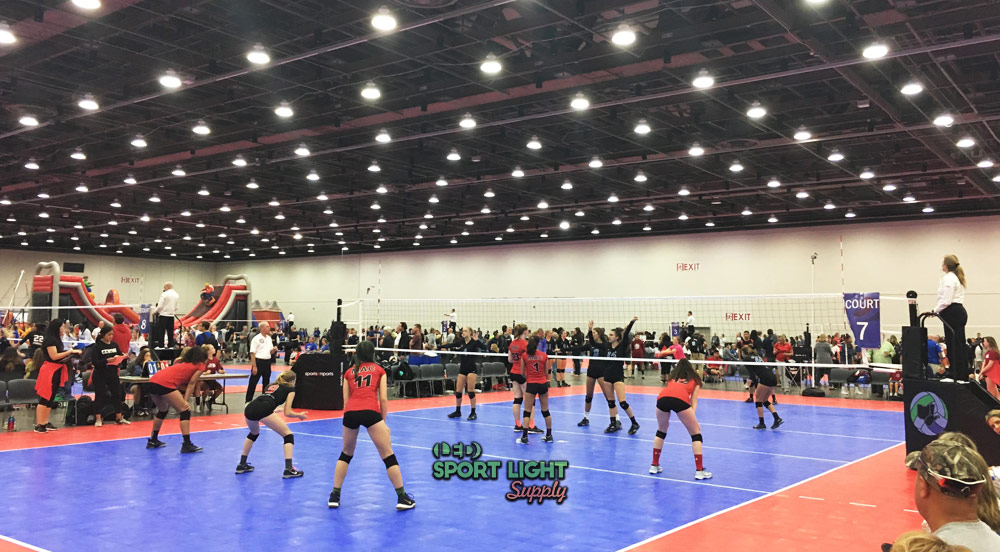
High bay flood lights are the most commonly used fixtures in indoor volleyball courts. Typically, these lights feature a design with a hook, a chain, and a lamp holder, making them easy to install by either fixing them to the wall or hanging them from a bracket.
While individual high bay lights may be relatively expensive, the overall cost of installing multiple units is often lower compared to other specialized lighting options. High bay lights are well-suited for volleyball courts due to their broad beam angle and the ability to use energy-efficient LED lamps. You can select from beam angles of 45, 60, or 90 degrees to ensure comprehensive light distribution and proper illumination across the court.
Panel Lights
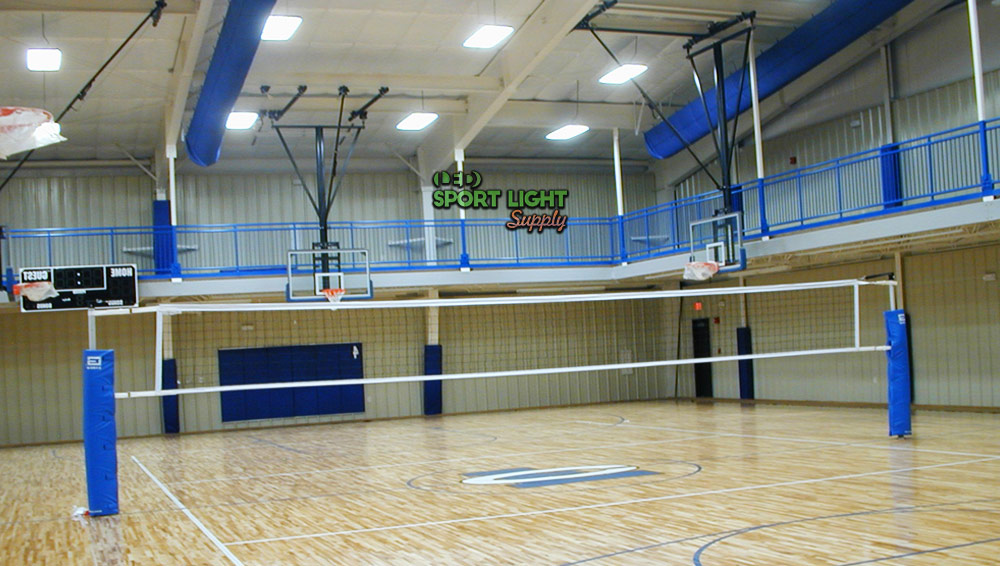
Panel lights are another effective choice for indoor volleyball courts. These lights typically include a diffuser that softens the luminous flux, which enhances lighting uniformity and minimizes glare.
LED panel lights are designed to be flat and thin, which is achievable due to LED technology. Their modern and minimalist design allows them to blend seamlessly into the ceiling. Panel lights come in two versions: recessed and ceiling-mounted. Recessed panels are installed into a ceiling cutout, providing a sleek, contemporary look. They are usually mounted with clips or frames and fit into holes made in plasterboard ceilings.
Light Tubes
Light tubes are lightweight and easy to install, but they offer less brightness compared to other lighting options. To adequately illuminate a volleyball court, numerous light tubes are required, particularly to cover areas from the service line to the centerline.
An effective lighting layout is crucial to ensure adequate lux levels across the court, especially in key areas such as the attack lines and back rows. Light tubes vary widely in model and price, ranging from a few dollars to $400 or more per lot. Fluorescent and LED light tubes are the most common types available on the market today. The varying costs and quality of different models in each lot can affect overall lighting performance.
| Light Type | Pros | Cons |
|---|---|---|
| High Bay Flood Lights | Broad beam angle, energy-efficient, good for overall illumination | Higher initial cost, needs multiple units for full coverage |
| Panel Lights | Improved lighting uniformity, reduces glare, modern design | Recessed installation required for aesthetic look |
| Light Tubes | Lightweight, easy to install, cost-effective | Less bright, requires numerous tubes for adequate coverage
|
Indoor Volleyball Court Lighting Design and Layout
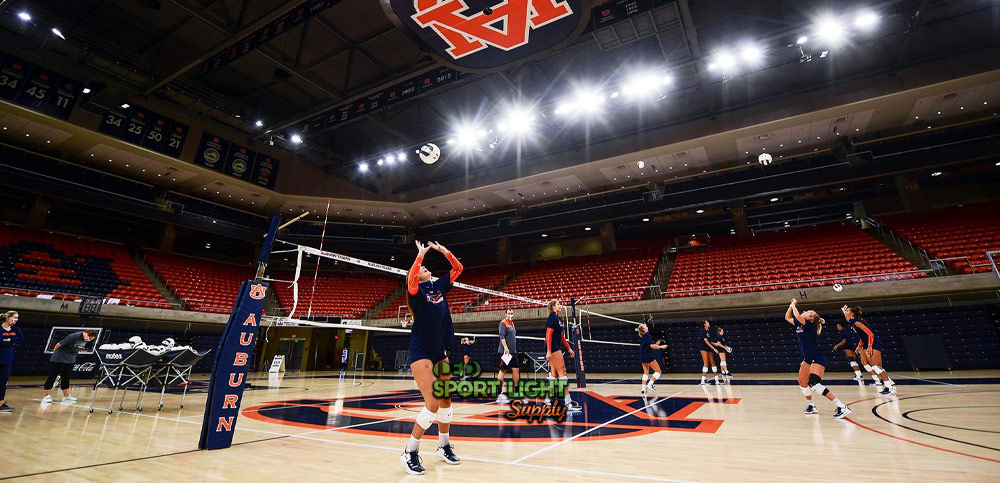
Average Ceiling Height of an Indoor Volleyball Court
The ceiling height of an indoor volleyball court is influenced by various regulations, such as those set by the USA Volleyball organization, which mandates a minimum height of 23 feet (7 meters). This requirement applies to high school sports facilities as well.
When designing the lighting for a volleyball court, it’s crucial to consider the net height, which varies by age group. For example, younger players use a lower net compared to older or adult players. The ceiling height must accommodate all play situations, including high serves and spikes, ensuring that the lighting does not interfere with the game.
Direct or Indirect Lighting
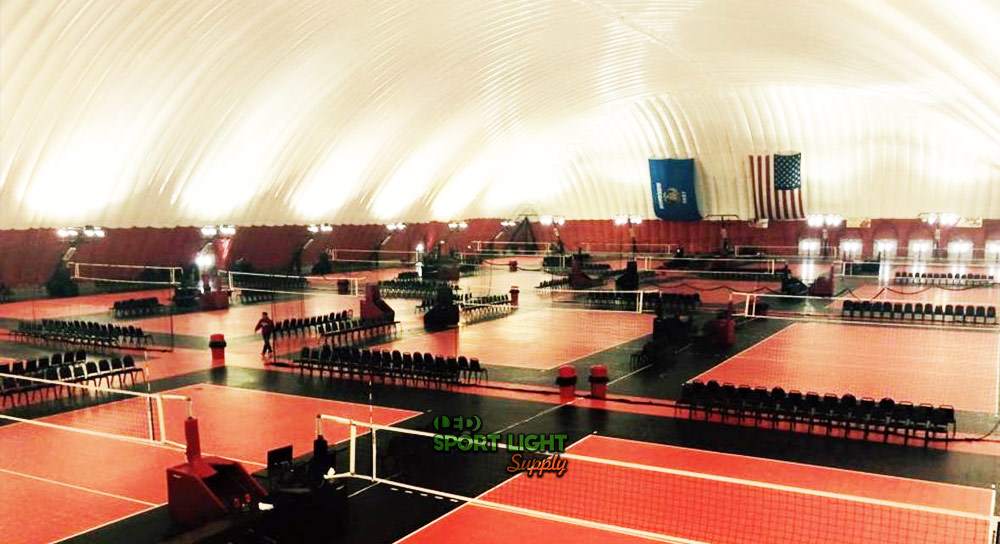
Direct Lighting
Direct lighting involves fixtures that point downward, providing focused illumination. This method ensures that light is cast directly onto the court, enhancing visibility in specific areas.
Indirect Lighting
Indirect lighting, on the other hand, uses fixtures that direct light upwards, which then reflects off the ceiling to illuminate the court. This type of lighting is becoming more popular in volleyball facilities due to its ability to create a well-distributed light environment. However, for effective results, it should be integrated into the initial architectural design and supplemented with direct lighting sources to achieve the necessary light intensity.
Lux Requirements
Recreational Use: 200 Lux

For recreational volleyball play and basic drills, a minimum of 200 lux is typically sufficient. This level supports activities such as serving, setting, hitting, passing, blocking, and digging. Achieving 200 lux can be accomplished with cost-effective LED lights, such as a high-power high bay LED light positioned above the center line or two panel lights installed on each side of the court.
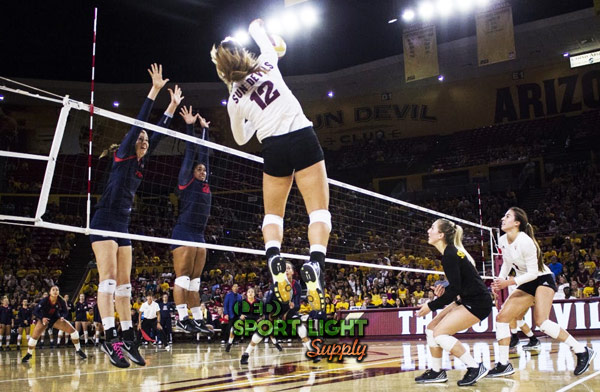
High School or College Gymnasium: 300 to 500 Lux
In high school or college settings, where the focus is on training and skill development, a lighting level of 300 to 500 lux is recommended. This ensures adequate visibility for both players and coaches. Generally, up to six recessed panel lights are used per court. Operating costs vary based on the training program and methodology. For less intense training sessions, reduced lighting may be sufficient.
Broadcasting: 800 to 1000 Lux
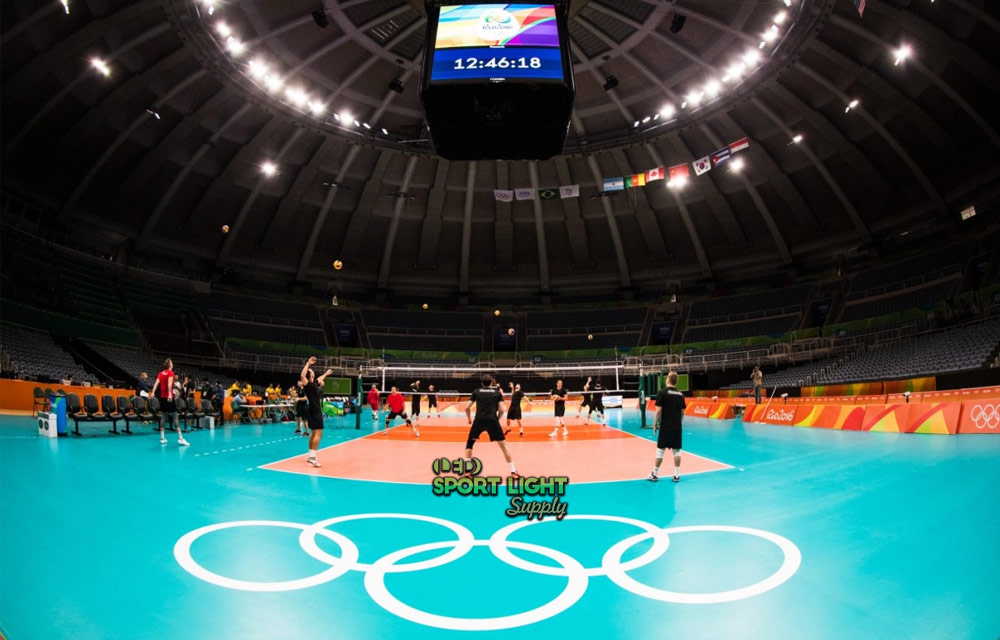
For professional-level broadcasts, such as those for the Olympics, lighting requirements increase to 800 to 1000 lux. This higher level of illumination is necessary to reduce scene contrast and accommodate multiple camera angles. The lighting design includes vertical lighting along with spotlights and additional sources to balance the primary light. Remote lighting control is crucial to adjust intensity during broadcasts, especially during timeouts and key moments.
Lighting Uniformity
Lighting uniformity on a volleyball court should ideally fall between 0.5 and 0.7. This range helps to avoid harsh shadows and bright spots, which are essential for maintaining player visibility and safety during intense plays. Optimal uniformity requires high-quality fixtures and can increase energy costs. However, compromising on uniformity can significantly affect visual clarity and safety.
Spacing Between Ceiling Lights
For most competitive levels, the spacing between ceiling lights should range from 3 to 5 meters. This spacing ensures even distribution of light across the court, which can be adjusted based on the specific dimensions of the facility. A photometric report analysis can provide precise calculations for light spacing, considering the type of light source used. LED high bay lights, for example, may require different spacing compared to fluorescent light tubes. The aim is to meet the lighting needs of both players and spectators effectively.
Indoor Volleyball Court Lighting Cost Analysis
The cost of installing a professional lighting system for an indoor volleyball court depends on several factors, including:
Factors Affecting Cost
Lux Requirements
The amount of illumination required for an indoor volleyball court is measured in lux, and it plays a crucial role in determining the overall cost of the lighting system. Lux levels define how bright the court needs to be for optimal play and visibility. Higher lux levels necessitate more powerful lighting fixtures to achieve the desired brightness. This increased power often translates into higher costs, both in terms of the initial investment in lighting equipment and the ongoing energy consumption. For instance, a court designed for competitive play or broadcast events will need a much higher lux level compared to a recreational or training facility, thereby influencing the choice and cost of lighting solutions.
Court Size
The dimensions of the volleyball court are another key factor influencing lighting costs. A standard volleyball court measures 18 x 9 meters, but the size can vary depending on the facility’s specifications. Larger courts require more lighting fixtures to ensure that the illumination is evenly distributed across the entire playing area. Ensuring uniform lighting is essential to avoid shadows and dark spots, which can affect players’ performance and safety. Consequently, the cost increases with the need for additional fixtures and possibly more complex installation requirements to cover the larger area adequately.
Ceiling Height
Ceiling height significantly impacts the type of lighting fixtures used and their installation costs. Courts with higher ceilings may necessitate specialized lighting solutions, such as high bay lights or fixtures with adjustable mounts to ensure the light reaches the playing surface effectively. Higher ceilings can also increase installation complexity and costs due to the need for specialized equipment or mounting systems. Additionally, the height of the ceiling affects the light distribution and intensity, requiring careful planning to achieve the desired illumination levels.
Light Source
The choice of light source—whether LED, metal halide, or fluorescent—affects both the initial costs and ongoing energy consumption. LEDs are known for their high efficiency and long lifespan, making them a popular choice despite their higher upfront cost. They offer significant savings in energy and maintenance over time. Metal halide lights provide good illumination but are less efficient and have shorter lifespans compared to LEDs. Fluorescent lights, while often more affordable initially, tend to have lower efficiency and may require more frequent replacements. Each light source has its own set of benefits and drawbacks, impacting the total cost of ownership and the decision-making process for lighting design.
Maintenance Costs
Maintenance costs are a critical component of the total expense associated with lighting systems. Different types of light sources have varying maintenance needs. For example, LEDs generally require less frequent maintenance compared to metal halide or fluorescent lights, which may need regular replacement and servicing. The cost of maintaining a lighting system can add up over time, particularly in high-usage facilities where lights are in constant operation. Regular maintenance ensures optimal performance and longevity of the fixtures but can contribute to the overall cost of the lighting system.
Renovation Costs
Renovating an existing lighting system can be a substantial expense, especially if the project involves significant modifications to the facility’s infrastructure. Upgrading to newer, more efficient lighting technologies might require changes to the electrical systems, mounting structures, or even the physical layout of the court. These renovations can be costly and need to be factored into the overall budget for the lighting system. The complexity of the renovation will depend on the existing setup and the extent of the upgrades being implemented.
Utilization Rate
The utilization rate of the volleyball court directly impacts the lifespan of the lighting fixtures. Facilities with high usage, such as those hosting frequent matches or events, will experience more wear and tear on their lighting systems. This increased usage can lead to a shorter lifespan for light sources and may necessitate more frequent replacements or upgrades. Consequently, facilities with high utilization rates may need to invest in more durable and higher-cost lighting solutions to handle the demands of frequent use.
Cost Calculation Example
To estimate the cost for a volleyball court that measures 18 x 9 meters (162 square meters) and requires a lighting level of 500 lux:
Required Lumens
To determine the total lumens needed for an indoor volleyball court, use the following calculation:
| Lux Standard | Court Area | Light Loss Factor | Required Lumens |
|---|---|---|---|
| 500 lux | 162 square meters | 1.2 | 97,200 lumens |
Calculation
500 lux × 162 square meters × 1.2 = 97,200 lumens
Converting Lumens to Wattage
Different types of lighting sources have varying lumen-to-watt ratios. Here is the calculation for each type:
| Light Source | Lumen-to-Watt Ratio | Required Wattage |
|---|---|---|
| LED Lights | 150 lumens per watt | 648 watts |
| Metal Halide Lights | 65 lumens per watt | 1,495 watts |
| Halogen Lights | 15 lumens per watt | 6,480 watts |
Cost Estimation
Estimate the cost based on the wattage required for each type of light:
| Light Source | Wattage Required | Cost Range |
|---|---|---|
| LED | 648 watts | $518.4 – $972 |
| Metal Halide | 1,495 watts | Higher |
| Halogen | 6,480 watts | Highest |
Conclusion
Choosing the right lighting for an indoor volleyball court involves evaluating several key factors that influence both upfront and long-term costs. High bay flood lights are commonly used for their broad beam angle and compatibility with energy-efficient LEDs, making them a cost-effective choice for large areas despite their higher initial cost. Panel lights offer excellent uniformity and reduced glare, integrating seamlessly into ceilings for a modern look. Light tubes are an affordable option but require more units for adequate brightness. Factors such as court size, ceiling height, light source type, maintenance, renovation costs, and utilization rate all impact the overall expense. Balancing these elements ensures that the lighting design provides adequate illumination, minimizes maintenance, and fits within the facility’s budget.
